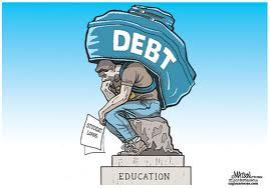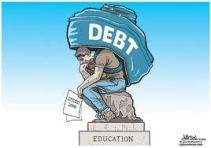From WiseBread New Graduate Help Center: Reyna Gobel, Student Loans Expert
Dear Not-Yet-In-Trouble Federal Student Loan Borrower,
You might have heard that the Department of Education will be sending out letters to millions of student loans borrowers. The letters target borrowers whose grace periods are ending, as well as borrowers who exhibit signs of trouble that could lead to defaulting on their loans. If you haven’t started repayment yet but are fretting about how you’re going to possibly repay all that money — stop worrying.
I’m writing you this letter to not only give you important details about student loan repayment, but also to help you be aware of potential issues well before trouble starts.
I Defaulted — Here’s How to Avoid My Mistakes
I defaulted on a federal student loan simply because I didn’t know it existed. I had over a dozen student loans from different lenders; I forgot about one loan and went into default. It’s easy to do, but it’s also easy to avoid. Just log in to the National Student Loan Data System. You’ll see all your federal student loans on this site, along with contact information. Either arrange to pay each individually, or consolidate them into one loan. This is also a great time to get a free credit report – it can alert you to any problems you might have, like having missed a loan or bill payment.
Then, know yourself. If you can’t keep track of each individual loan, you really need to consolidate them into one loan to streamline payments (ask your loan servicer about consolidation options). Once consolidated, you can still choose a plan where payments are based on income, such as Pay as You Earn. And if you’re interested in the public service loan forgiveness program, know that it’s only available through loans originated by or consolidated with Federal Direct Loans.
Realize That Even With the Pay as You Earn Plan, You Might Have Payment Problems
The income-based Pay as You Earn repayment plan bases payments on your income and family size, but it doesn’t fully consider your expenses if your circumstances change. For example, at some point, you may have to help support a sick parent or child. You could also have bought a home when your income was higher. After a pay cut, a majority of your income could go towards your mortgage.
If you experience a financial setback, you have three options:
- Call your servicer and see if your Pay as You Earn payment amount can be adjusted. You have to supply your income annually, and you may have forgotten to do so this year, causing your payments to set based a higher income level.
- Ask for a deferment or forbearance, which are temporary payment breaks. Taking a break should only be done if the situation isn’t permanent. Always take a deferment when possible over a forbearance when any of your student loans are subsidized. The government pays the interest on subsidized student loans during periods of deferment.
- If your income is lower because you took family leave for six months, you may not want to change your plan. However, for long-term pay cuts where your income-based repayment is too high for your budget, you should ask your servicer to also calculate payment options and see which payment option offers the lowest monthly payment.
Don’t Feel Embarrassed If You Don’t Know Something About Student Loans
I wrote two editions of a 240-page book on student loans, and I still don’t know everything about them. I read articles and play with the student loan repayment calculators every day. There’s always something new to learn. For instance, the public service loan forgiveness employer verification form wasn’t created until after the first edition was released. Now, thanks to that form, you can find out if you qualify for the public service loan forgiveness program right away and register for it right after you start working or after you’ve already started repayment — the choice is up to you. Never be afraid to ask your servicer questions about any of these programs.
Talk to Your Friends Who Are or Will Be in Repayment Soon
I’m not the only person who has experience with and advice about student loans. Talking to your friends can help you figure out repayment options and possibly pick better ones based on their choices and experiences. Just remember, they might have different circumstances than you, such as income level, children, or other debt that impacted their choices. Therefore, you shouldn’t copy their decisions. But you’ll be more informed and learn questions to ask your servicer. Plus, they may have missed payments, recovered, and now have advice about that. Learn from others’ student loan mistakes and victories.
The Most Important Part of This Letter?
The help you get doesn’t end here. You can tweet me anytime — @ReynaGobel— and ask questions. My articles will be posted here every week. You can ask me questions in my CollegeWeekLive web chats or get more helpful advice in my book CliffsNotes Graduation Debt.
Finally, remember you never want to receive a “dear troubled borrower” letter. The second you think you might miss a payment, talk to your loan servicer about options for a payment break or new repayment plan. With federal student loans, that one call will likely save your credit.
Reyna Gobel is a writer, author, public speaker, and student loans expert. Her financial advice appears on Wise Bread’s New Graduates Help Center, in her video course How to Repay Federal Student Loans, in CollegeWeekLive newsletters and keynotes speeches, and in her audiobook How Smart Students Pay for School, now in its second edition. Be sure to check out her website for more helpful information on repaying your student loans.


